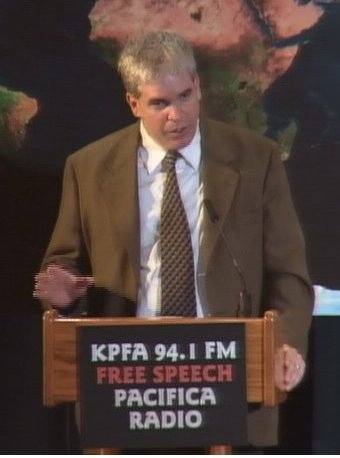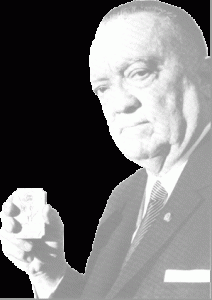Transcript from Visibility 9-11; A Basic Chemistry Lesson with Dr. Niels Harrit
As recorded on Visibility 9-11 with Michael Wolsey, April 8, 2009
Full interview with notes found here.
Transcript:
Niels H. Harrit on Visibility 9-11
April 10, 2009
Beginning at 17: 10 –
Michael Wolsey: Now, I took many classes in college and one of my science requirements that I had to take was indeed an introductory chemistry class, so I am not a complete idiot when it comes to chemistry, but I know that many of the listeners out there may never have taken a college class in chemistry so I thought it might be helpful to…maybe you could give folks a little bit of basic chemistry lesson and lets maybe take a well known chemical reaction that folks can relate to and maybe explain that.
Dr. Niels H. Harrit: The key word is nano thermite. I would split that in two and take the thermite first. Combustion; the campfire burning…because what is happening in the thermite is basically the same thing as when the campfire is burning. Heat is developed and the carbon in the wood is reacting with the oxygen of the atmosphere, and it is basically the same reaction going on in thermite. Wood burning is something that everyone is related to. Ya know wood is basically is carbon, it’s like coal burning. And when coal or gasoline or wood is burning it is reacting with the oxygen of the atmosphere and the reaction develops heat. So there are two to party; there are two ingredients in the reaction and in this case there is the coal and the oxygen and when they react they develop heat. And the reaction means electrons are being moved basically that what it is. Chemistry is the transformation of matter; of stuff. It is basically the same reaction going on in the thermite, except the role played by the oxygen, is now played by rust. And the role played by coal is now played by aluminum. So it’s the same kind of reaction as ordinary combustion it’s just that there are two other actors on the scene. And these actors now comes as tiny particles. When I say tiny, it’s a relative matter because in the classical thermite, you have pulverized rust and you have pulverized aluminum but still the grains are large enough for you to see by eye. This is like what you call flour and sugar. When you make a classical thermite, and this is an old invention from 1893 made by a German chemist called Goldschmidt and he discovered when he mixed finely divided rust with finely divided aluminum and got the reaction going, which is not that easy, I can tell you that, I have done it myself, but once the reaction is going it develops a tremendous heat and this heat is much much bigger than when the campfire is burning because the actors are mixed on beforehand. In the campfire you have to renew the air, the oxygen for the wood or for the coal to burn. And if you, if it doesn’t get enough air it doesn’t burn very hot, but in the thermite, these two actors who are to react with each other are mixed on beforehand as two powders. But in the plain thermite, these powders are relatively course; we are from a millimeter down to 1/1000th of a millimeter. Now in nano thermite the grains, the particles is much smaller which means that the two actors, the two who have to react with each other are much much more finely divided and they can interact much more intimately and much faster. So the energy developed as heat is now developed so fast that we are approaching what you might call an explosive. You can even make it an explosive by mixing in other stuff and that is the key of the nano. This is the way you make the particles and when you make the particles so small you have the opportunity to mix in other stuff and it is this other stuff that makes it an explosive because in order to be an explosive you have to develop gasses. An explosive is working because it reacts so fast, not because there are terribly much energy but it develops an enormous pressure so you kinda knock over, whether it’s a piece of concrete or it’s a steel beam, you knock it over by force. But the thermite can do both. It depends of the composition of the thermite. It can either develop heat or it can be designed to work as explosive. It can also be, what you call a rocket propellant, what you call rocket fuel like the boosters on the, what you call the Space Shuttle. This is nano thermite. So this is a third option for a version or category of nano thermite which develop a lot of gasses but pretty slowly for the boosters to raise the Space Shuttle into space. But if this reaction is very fast, you get a very high pressure and that is an explosive. So the nano thermite concept has the whole potential and those who are making new explosives for the American military, in their advertisements they call these materials for explosives, the call them smaller, cheaper, and nastier. This is the explosives of the future, this is the munitions of the future, there is no doubt about this.
Michael Wolsey: Now, Dr. Harrit common sense tells me that when you have particles of whatever it is, in this case we have aluminum and iron oxide, when we have these particles and we get increasingly smaller and smaller, common sense tells me that we get a larger amount of surface area as a result. Does this have any play in the way that nano particles act; the surface area?
Dr. Harrit: Definitely, that’s the whole thing, because the smaller the particle is, the greater the surface area. This is what you call, geometrical truth. Our bodies, well, excuse me this is because the surface goes with the radius squared, and the volume goes with the radius to the third. So the larger the body, the smaller the surface. And this is why an elephant gets very old because his metabolism is very slow because he doesn’t have a very big surface where he lose heat but a tiny mouse runs his whole life, they eat 22 hours in a day because when he is so small he loses a lot of heat so the surface is bigger. Now, so the smaller the particles, the bigger the surface means that a bigger fraction of the atoms are lying at the surface. But there is a lower limit for this process, when you’re talking about aluminum. And this is kind of special for aluminum because it must have a protective surface of aluminum oxide. It has to all the time. It’s about 6, roughly 4 to 6 nanometers thick. And one nanometer is one millionth of a millimeter or one billionth of a meter. You must transform this to inches, I’m not sure…but nanometer is very very very very small. So around every aluminum particle there’s a thin thin layer of aluminum oxide. And this means that there is a lower limit for how small the aluminum particles actually can be and still be aluminum. You see, because the smaller the particle, the bigger the surface and since you have aluminum oxide on the surface, there is a lower limit to how small the aluminum particles can be. This will be a radius of say, I’m not sure 20 to 40 nanometers before you lose the smallness of the thing. But the iron oxide actually can be…what we have… I would suppose that today you can make the material even much more advanced than the one we have found which goes back from 2001, because there has been some papers published since as to how probably this material has been prepared. Shall I continue, because when you are doing nano particles there basically two completely different ways of doing it and one we call top-down procedures, where you, when you’re starting from a big thing and making it smaller particles. But there is also a bottom-up way of making particles where you start from atoms and the molecules and this is how this material has been made. You do not start with a big lump of rust and then grind it in a mill. You start from the atoms down and build the particles to the size you want them and you can determine this. You can get the particles the size you want by chemistry and going back to your question, this is where the chemists come in.
Michael Wolsey: That’s fascinating. I wondered how they were able to manufacture these small particles and I’ve had in my mind a picture like you just described of a mill, some sort of a mill grinding down big pieces into small pieces but it doesn’t work that way. Is that true for the iron oxide and for the aluminum?
Dr. Harrit: The aluminum small particles can be made in different ways. You can actually do both and get aluminum particles of this size, but this is a guess, because there is several options, you can evaporate aluminum and you can get…. I shouldn’t say this. I shouldn’t guess on how the aluminum particles were made. I know more about the iron oxide and these iron oxide particles you make from atoms. So you build them from the bottom up approach. You start with something even smaller, namely atoms, and you’re building the particles. For the aluminum particles, there are several options and we have so much more to do. We still have the problem of finding out, because the aluminum particles are not spheres, they are not round. They are small platelets and so we have to look into aluminum particle technology in order to pursue that trail and find out how the aluminum particles were made. But what would be even better, if someday, those who made these materials would step forward and tell us how they did and it will save us a lot of time, of course. But then we are talking about the investigation which has to come.
Michael Wolsey: Very interesting stuff here. Now, in my interview with Dr. Jones, and you’ve touched briefly on this just now, Dr. Jones talked about there was an organic compound that was present in these little red chips but due to the testing methods they were using, they were unable to determine exactly what the organic compound is. Now, the way I understand it is this organic compound was a contributor to the reaction in that this was the ingredient that supplied the gasses, and you’ve touched on this that gasses are what do most of the damage in an explosion.
Dr. Harrit: Eventually. It’s perfectly true. We don’t know this yet. There is so much…there are so many experiments yet to be done. One thing which is particularly interesting is if this organic material also contains fluorine, because there are recipes, there are procedures which has been published where they are making nanothermites of this kind and incorporating what we call a perfluorinated alkane. I know, this is chemical stuff but…it’s between carbon…there are carbon compounds with fluorine in. Now when I first saw this, I couldn’t understand why they put this in. Teflon is an example of this. Teflon is an example, this is a polymer which composes of carbon and fluorine and you know this from your pans, and…pots and pans that are Teflon coated. Teflon is a material made of carbon and fluorine, and actually, it’s polymers like that which you can add to the thermite, eventually. Now, one problem with the investigation which has just been done is that we cannot see fluorine because the response from fluorine lies under the iron response, which we see all the time. So we cannot see, determine if there are fluorine in there or not. Now, the presence of fluorine is interesting, because in the thermitic process, when this burns, or reacts, the fluorine will pick up the aluminum because fluorine has a greater affinity for aluminum than oxygen. This means that the oxygen, which should have taken the aluminum, is now free to form gasses. That means that the presence of fluorine is one option if you want to make an explosive. You can add fluorinated polymers to the mixture. This is one way of doing it and they can actually be added in a few different ways. There are different procedures for making this. I didn’t say this…this anecdote. The first time I saw this I wondered, because you know from the Teflon on your pan that carbon/fluorine materials are very resistant and they cannot burn. So why put something in there which cannot burn?And the answer as I just gave it to you is the fluorine is liberated to unite with the aluminum, so you do not get aluminum oxide, which is the white cloud. You’ve probably seen pictures that Steven Jones has shown where the thermite reaction produced, normally, aluminum oxide as a white cloud over the reaction mixture. But when fluorine is present, the fluorine takes the aluminum so the oxygen is free to form gasses and this is one way of turning the nanothermite into an explosive. There are other ways. Just the same…that you pack…. if you have a grenade, and if you have a reaction which goes on at 300 degrees centigrade, in the shrapnel, what do you call it, in a closed grenade, it must explode. Because what you have in there is explosively gasses. You don’t even have oxygen in there. It disassociates to atoms. So there are many…actually many ways that the thermite can be turned into an explosive. But the trick with the organic compound is one of them, yes.
Michael Wolsey: I guess the thing with the gasses is kind of confusing to me, I wonder if there is a way that you can explain how the gasses are produced, maybe for the layman to understand how so much gas is produced and how that gas can do so much damage?
Dr. Harrit: An explosive is defined as a process which develops gasses very quickly. In the ordinary black gun powder the gasses being developed thereis carbon dioxide which everyone knows these days of the green house effect, and sulfur dioxide and some nitrogen oxide, and this is a mixture you know was invented in China, it was 1200 years ago or more, yea, about that. You mix carbon and sulfur and saltpeter and you get reacting and this develops actually not so very rapidly, but it develops rapidly carbon dioxide and sulfur dioxide and the gasses developed can then push a cannon ball out of the barrel. And it was not very efficient in the beginning, but has become more efficient later on. Now these days…. but it’s a very nice picture actually, on what nano, on what the nano thermite is because in the gun powder, you have the ingredients I told about these chemical partners we have to react. In the gun powder, it is also a mixture of powders. It’s carbon and it’s sulfur and it’s saltpeter. But in modern explosives, the two partners are now in the same molecule which means that the trajectory of the electrons have to do when getting from one side to another is much smaller and this is why TNT or nitroglycerin or dynamite which are…. they are so efficient because there the two partners are in the same molecule, and these are explosives. Now what happens when turn you ordinary thermite into nanothermite is that you are approaching the same situation as in a molecule with the classical explosives. There is a convergence between what we call bulk materials and what we call molecular materials and they are converging into nanotechnology. So you get the best of two worlds. You get all the energy of the thermite. There is more energy in the thermite than in dynamite or TNT. There is more energy in the thermite, but the classical thermite is slow. But when you convert it into nano technology it becomes fast and so you get an explosive which is more efficient than the classical explosives. It is smaller, cheaper, and nastier.
End 37: 52
Picking back up at 52: 00
Michael Wolsey: One of the things about this nanothermite that I have learned is that it will ignite at a much lower temperature than your traditional thermite. I wonder what is it about the nano sized particles that make it ignite at a lower temperature?
Dr. Harrit: Personally, I’m not quite sure. We have discussed this at some length and I am not sure that we agree all on the author team on this so maybe I should be careful…I think it would be fair enough to refer to the intimate mixing of ingredients. But it’s true, we are not quite sure…but we are perfectly in line with what has been published by other people on comparable materials; it also sets off at the same temperature, but why?. . . personally, I thought…let me put it this way that the determining factor would be the melting of the aluminum and I would expect the aluminum particles to melt at a lower temperature than aluminum itself. I think that pure aluminum is 1628, it depends on the alloy, around that. And so I would expect…. this is common for metal particles that they have a lower melting point than the bulk material. Within the team of authors there appeared a paper which shows actually the melting point of aluminum particles are not substantially lowered from that of the bulk so we’re not quite sure we can answer this question in depth. We can just refer to the same number has been found by other people in comparable materials. I’m not quite sure why it takes off at 430 but it does. And you have to trust your experiment. It’s still safe, it’s still very much safe and those who start, who started to prepare these materials telling other people, this is from constance proceedings to a large extent and from internal reports and to a lesser extent, from published papers…They’re not so much about it. But they want to sell, of course, their materials, this is national laboratories so they have to renew their grants so they are telling about these new materials they have developed and they are bragging about the safteyness of handling these materials…they are very very safe to handle. They do not go off unintentionally which is a huge advantage, of course, for explosives to be handled by laymen or ordinary construction workers.
Michael Wolsey: Now, Dr. Harrit, one of the things that I have learned about your paper that you guys put out is that one of the experiments that you guys performed involved this solvent Methyl Ethyl Ketone (MEK) solvent, and one of the things that you discovered was that there was indeed elemental aluminum in the red/gray chips. Now can you explain the listeners, and maybe this is a little bit of repetition because….
Dr. Harrit: No, because It’s a very important experiment because when the aluminum is there as particles of elemental aluminum they can move around. The particles are small, but they are not bound chemically to other elements. Now if aluminum, take a piece of rock, which is aluminum silicate, its still aluminum, but the aluminum is bound with other elements and it cannot move around. So when you discover that the aluminum in your particle can move around when you treat it with a solvent which has absolutely no interaction with the aluminum, it means that you are breaking up…when you break up the structure the aluminum are free to walk around, which means they are there as particles; they are not bound, and this is a point of this experiment.
Michael Wolsey: I see, so what does it mean to your experiments that elemental aluminum was indeed found?
Dr. Harrit: Well, this is very important because I told you the picture about the wood or the coal burning in the wind. There you have two reaction partners, you have the fuel and you have the oxygen which in general terms is called the oxidant. So you must have the fuel and an oxidant each time you’re doing energetic reactions. And in this case, the aluminum is the fuel; it corresponds perfectly to gasoline in a car. This is the fuel. It must react with something else which in this case is rust and probably also some silicones but you see, aluminum is the fuel, you have to prove that aluminum is there as a fuel. Once it is burned it can be something which could look like silicate, but then it’s being bound into oxygen or as I told you before, to fluorine. Maybe the picture with the gasoline and the car is pretty good because there you put your gas in your car but in order for it to react in the engine, you have to suck in air through what you call the carburetor. Do you call it that in English?
Michael Wolsey: Yes.
Dr. Harrit: OK, you suck in air in the carburetor, and it reacts and the engine gets going and you have to have two ingredients each time you’re doing your reaction here, you have to have a fuel, and you have to have. . . and the oxidant. Now in the explosives, these two partners are within the same molecule but the trained chemist can look at the structure and see now this end, there you have what we should call the fuel here. At the other end you have the oxidant. So it’s all the time the same game being played but the partners are kind of different. You always have a fuel, and you always have an oxidant. And the fuel can be coal or wood or gasoline and the oxidant will be air or oxygen in the air, but in this case, it’s the same game you play, it’s just other actors.
Michael Wolsey: Sure and the actors in this case would be aluminum and iron oxide.
Dr. Harrit: Yes sir, and probably there is some silica, and a little bit more complicated but basically this is the role played in the classical thermite at least. These are the two actors on the scene; Aluminum and iron oxide, yea.




























